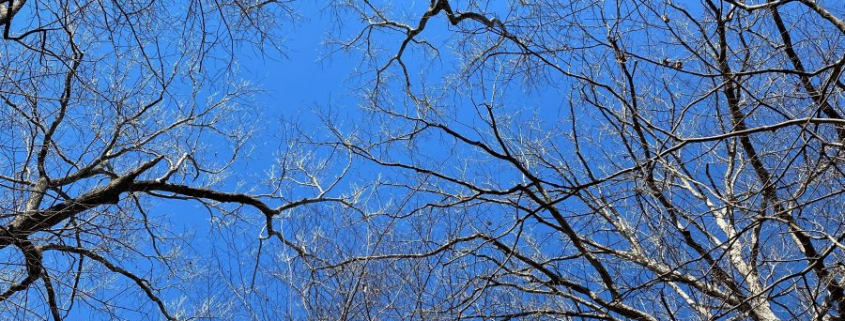Adding a New Dimension to my Tree Appreciation
I’ve observed since my undergraduate forestry education that trees grow taller on richer sites, a fact that doesn’t require a bachelors degree to confirm. The central Appalachian forests where I worked undergraduate summers clearly evidenced the correlation. Forests on lower concave slopes facing the northeast quadrant (i.e. cove sites) performed best, with white and red oaks, yellow poplar, cucumber trees, black cherry, white ash, basswood, and sugar maple standing fat and reaching tall. Upper convex positions supported chestnut oak, red maple, Virginia pine, beech, and mixed oaks standing far shorter and with fewer and smaller stems per acre. Upper west and south facing slopes performed poorest of all. Fifteen years later, my doctoral research quantified the relationship between such site factors and forest productivity within the Allegheny Hardwood forests of NW PA and SW NY. The same relationships hold in our southern Appalachians. Cove sites win the mountain tree-height medals. Here in north Alabama, our river bottomlands likewise reign supreme.
Since retirement, I’ve wandered our north Alabama wildlands observing much about soil-site and tree relationships, without aid of an instrument for measuring tree height. Alas, I’ve purchased a clinometer (measures vertical percent and degrees) and a 100-foot tape (below left). I celebrate being able to measure standing tree height. It’s so simple — measure 100 feet from the tree base and read percent down to the tree base (I’ve been using it to-date in relatively flat bottomland forests) and up to the center-top. For example, I measured a sweetgum recently: five percent down to base and 108 to the top. Add the two to reveal the tree’s 113-foot height. I plan to often include tree heights in future blog Posts as I continue to explore north Alabama wildness. Standing 100 feet from the base, Jerry Weisenfeld takes a reading to the tree top.

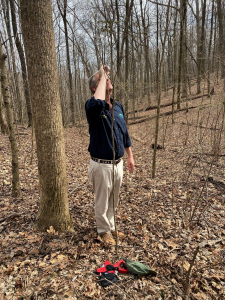
I offer with this Post some of my early measurements from the Wheeler National Wildlife Refuge bottomland hardwood forests (February 24, 2021) and on the Flint River floodplain forests at the Goldsmith-Schiffman Wildlife Sanctuary (February 25, 2021).
Wheeler National Wildlife Refuge
This 21.8-inch diameter shagbark hickory stands at 115 feet. Until procuring the clinometer, I could only estimate with eyes long-removed from my active forestry research days. My once reliable estimating skill had faded with the years. Now I can begin to recalibrate!
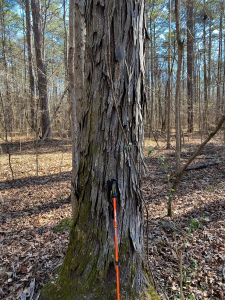
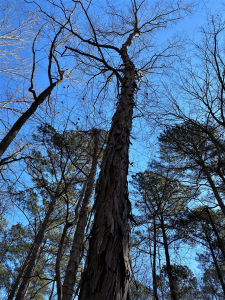
A 20.3-inch diameter chinkapin oak stands at 110 feet. For rough comparison, that’s equivalent to an 11-story building!
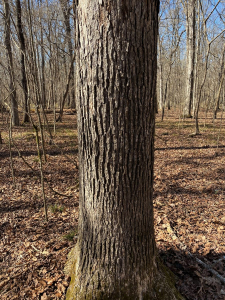
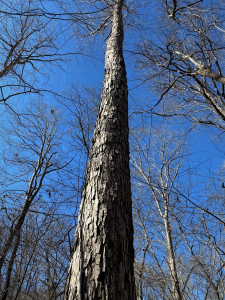
Yellow poplars are often the tallest trees I encounter. This 32.9-inch diameter specimen stands at 118 feet. As I begin to incorporate height measurements into these Posts, I will reflect more deeply on the relationship between site quality and height, and the ongoing battle among trees for light, water, and nutrients.
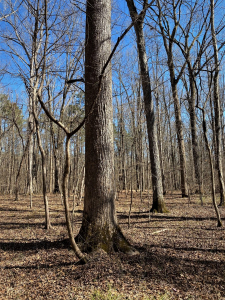
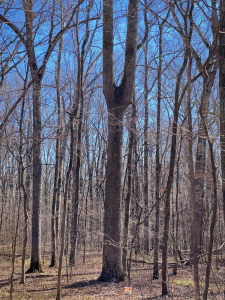
Across the Refuge’s bottomland forests, loblolly pine intermixes as microsite shifts towards better drained soils. The loblolly (dead center in photo below), 100 feet from where I stood, is 24.7 inches in diameter and reaches 114 feet above the forest floor. These 100-foot-plus heights are impressive enough when viewed from below. However, I imagine standing on the roof of an 11-story building, gazing with head spinning (I am not comfortable with heights) over the edge to the ground way-too-far below!
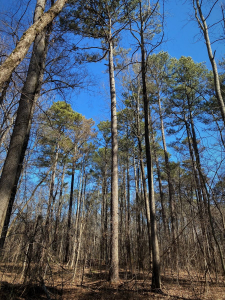
Rich riparian sites along the Tennessee River, combined with our annual rainfall at 55 inches, produce forests worthy of admiration and inspiration!
Goldsmith-Schiffman Wildlife Sanctuary
Although not along the Tennessee River, the Sanctuary is similarly riparian-situated along the Flint River. This 22.0-inch diameter sweetgum reaches 113 feet into the canopy. The two photographs immediately below show the 100-foot tape attached to the base (left) and with the view along the tape back to the base (right). I’ve discovered that my trusty iPhone camera does not depict horizontal distances as I wish. The tree 100-feet away appears as tiny and insignificant.
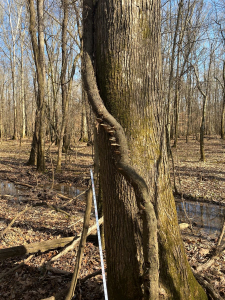
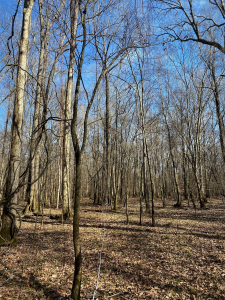
Yet, under it, peering into the crown, the tree stands impressively.
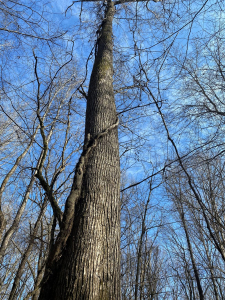
I’m fascinated with tree height and the intense competition for available upper-canopy sunlight.
Gazing into the Canopy
I am growing fonder and fonder of the vertical forest perspective, gazing directly into the business end of our sylvan citizens. In fact, I vow to spend more time lying on my back looking into the canopy. I’ll make sure the area where I recline is free of snakes, poison ivy, and other distractions!
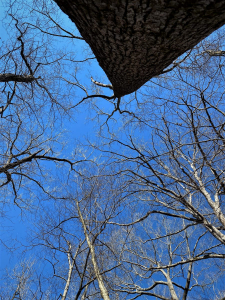
Over the course of my many years in forest practice, I seldom assumed such position. Now, retired, I will do as I please. No worry about appearing to loaf! In fact, I won’t accept the term loafing. Instead, we’ll refer to it as reclined deep contemplation!
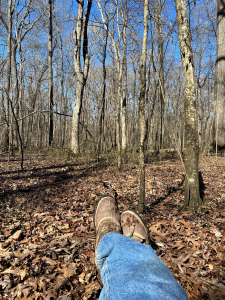
Contemplation that triggers youthful memories. I recall summer days as a youngster, lying on my back peering skyward, and feeling as though I might fall up into the sky. I feel an echo of those childhood sensations as I now gaze into the canopy, drawing out greater appreciation for the ten-story height, somewhat mimicking a reverse fear of heights, a mirror-version of being on the rooftop looking down. One may think me odd, yet I accept the sensation with glee. Anything I can do mentally to deepen my appreciation for scale assists my embrace of Nature’s beauty, magic, wonder, and awe!
Thoughts and Reflections
I offer three observations:
- Understanding the forest requires gazing into the canopy
- Good grounding and rich nourishment make all the difference… in tree height, and in people’s character
- A scientist, I multiply my admiration and inspiration with measurement
Inhale and absorb Nature’s elixir. May Nature Inspire, Inform, Humble, and Reward you!
Note: All blog post images created & photographed by Stephen B. Jones unless otherwise noted. Please circulate images with photo credit: “©2021 Steve Jones, Great Blue Heron LLC. All Rights Reserved.”
Another Note: If you came to this post via a Facebook posting or by an another route, please sign up now (no cost… no obligation) to receive my Blog Post email alerts: http://eepurl.com/cKLJdL
And a Third: I am available for Nature-Inspired Speaking, Writing, and Consulting — contact me at steve.jones.0524@gmail.com
Reminder of my Personal and Professional Purpose, Passion, and Cause
If only more of us viewed our precious environment through the filters I employ. If only my mission and vision could be multiplied untold orders of magnitude:
Mission: Employ writing and speaking to educate, inspire, and enable readers and listeners to understand, appreciate, and enjoy Nature… and accept and practice Earth Stewardship.
Vision:
- People of all ages will pay greater attention to and engage more regularly with Nature… and will accept and practice informed and responsible Earth Stewardship.
- They will see their relationship to our natural world with new eyes… and will understand more clearly their Earth home.
Tagline/Motto: Steve (Great Blue Heron) encourages and seeks a better tomorrow through Nature-Inspired Living!
Steve’s Three Books
I wrote my books Nature Based Leadership (2016), Nature-Inspired Learning and Leading (2017), and Weaned Seals and Snowy Summits: Stories of Passion for Place and Everyday Nature (2019; co-authored with Dr. Jennifer Wilhoit) to encourage all citizens to recognize and appreciate that every lesson for living, learning, serving, and leading is either written indelibly in or is powerfully inspired by Nature.
I began writing books and Posts for several reasons:
- I love hiking and exploring in Nature
- I see images I want to (and do) capture with my trusty iPhone camera
- I enjoy explaining those images — an educator at heart
- I don’t play golf!
- I actually do love writing — it’s the hobby I never needed when my career consumed me
- Judy suggested my writing is in large measure my legacy to our two kids, our five grand kids, and all the unborn generations beyond
- And finally, perhaps my books and Blogs could reach beyond family and touch a few other lives… sow some seeds for the future


All three of my books (Nature Based Leadership; Nature-Inspired Learning and Leading; Weaned Seals and Snowy Summits) present compilations of personal experiences expressing my (and co-author Dr. Wilhoit for Weaned Seals and Snowy Summits) deep passion for Nature. All three books offer observations and reflections on my relationship to the natural world… and the broader implications for society. Order any and all from your local indie bookstore, or find them on IndieBound or other online sources such as Amazon and LifeRich.

